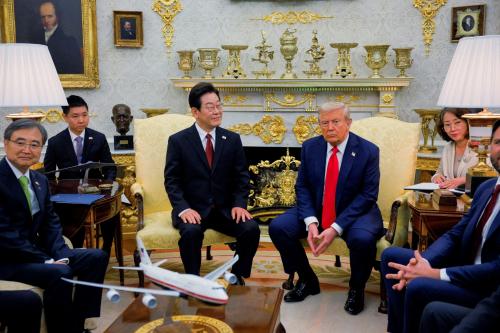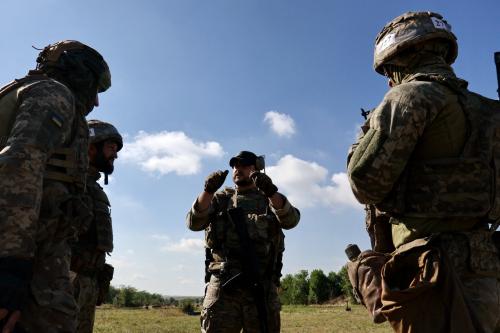As the Ukraine crisis has developed and fears of a broader Russian military intervention have grown, the Organization for Security and Cooperation in Europe’s (OSCE) Vienna Document on confidence- and security-building measures and the Open Skies Treaty have been used to provide some transparency regarding Russian military activities. In a recent interview, Russian Deputy Defense Minister Antonov disputed that Russia had deployed thousands of troops near the Ukrainian-Russian border. Antonov remarked that there are agreements on conventional arms control and that “these instruments can permit everybody to verify, to know about undeclared military activities…”
As the potential for conflict between Ukraine and Russia looms, participants in conventional arms control agreements, including the Vienna Document and Open Skies Treaty, are seeking to clarify the specifics of the Russian military build-up on the Ukrainian border. Deemed relics of the Cold War by many, the utility of these agreements has been underscored by the Ukraine crisis. These agreements will not be a panacea to resolve the crisis, and Russia has been uncooperative in fully adhering to their requirements, but their ability to increase transparency has nevertheless yielded some valuable benefits.
First, the Vienna Document has provided useful indicators about the Russian military build-up near Ukraine. The document was originally created in 1990 but has periodically been revised, most recently in 2011. The document is an agreement between 57 states, all party to OSCE. The documents consists of a set of confidence- and security-building measures to enhance transparency, including an annual exchange of military information, on-site inspections and notifications of certain types of military activities.
Beginning in early March, the OSCE convened an observation team of 56 unarmed military and civilian personnel from 30 party states to assist in monitoring military developments in Ukraine following Russia’s occupation of Crimea. The observation team was assembled under Chapter III of the Vienna Document, which “allows for voluntary hosting of visits to dispel concerns about unusual military activities.” Through the Vienna Document, the OSCE observation team has conducted inspections along the Ukrainian border. However, the observation was refused access into Crimea to observe military activities there.
Under different provisions within the document, OSCE members are allowed to carry out three inspections and two evaluation visits in Russia per calendar year. Earlier this year, Russia conducted large military activities in northwestern Russia, distinct from the military exercises on the Ukrainian border. Latvia and Switzerland each conducted one inspection in that time frame, leaving only one inspection available for the more recent military build-up on the Ukrainian border. For the last inspection, Ukraine assembled a team to monitor developments in the Belgorod and Kursk regions of Russia near the Ukrainian border. Additionally, both evaluation visits, intended to gather specific information about military units in garrison, were used on the Russian military exercise earlier in the year.
Because of the exhausted quotas, the Vienna Document has been limited in its ability to garner information on the ongoing military build-up on the Ukrainian border. While Russia could voluntarily allow for additional inspections or evaluations, there are currently no indications that Russia is interested in doing so.
Aside from on-site inspections, the Vienna Document requires states to notify other parties to the treaty of certain military activities. In one stipulation, the document requires 42 days prior notification of certain military activities, specifically those exceeding 9,000 troops, 250 tanks, 500 armored combat vehicles or 250 pieces of artillery. A second provision calls for the OSCE to monitor all military activities exceeding 13,000 troops, 300 tanks, 500 armored combat vehicles and 250 pieces of artillery. Finally, parties to the document will carry out no more than one military activity every three years involving more than 40,000 troops, or 900 tanks, or 2,000 armored combat vehicles or 900 pieces of artillery.
It is estimated that Russia currently has 40,000 troops deployed near Ukraine’s eastern border. Russia has not provided advance notification to OSCE members of the military buildup, despite being well over the numerical requirements under the Vienna Document.
In addition to the Vienna Document, the Open Skies Treaty has provided information about Russia’s military build-up on the Ukrainian border. Signed in 1992, the treaty allows its 34 members to conduct a predetermined number of flights to collect imagery of territory of other members of the treaty. All aircraft must be equipped with specific sensors to ensure that the data collected is not excessively detailed. For example, camera resolution is limited. While some states party to the treaty maintain their own National Technical Means (e.g., imagery satellites) that provide more accurate imagery intelligence, an important goal of the treaty is to enhance confidence amongst parties to the treaty by granting all the opportunity to collect imagery.
Two different sets of observational over flights have been conducted in response to the Ukraine crisis. The first set was permitted under Annex L of the Open Skies Treaty, which allows states on a bilateral and voluntary basis to conduct observational flights. On March 13, Sweden conducted an observational flight over Ukraine, followed by a March 14 observational flight over Ukraine conducted by the United States. On March 20, Ukraine carried out an observational flight over Russia under Annex L of the treaty. In addition to the observational flights permitted under Annex L, regular quota flights have been used to monitor the situation in Ukraine. On March 19, Romania flew over Ukraine and on March 20, the U.S. and Germany jointly conducted an observational flight over Russia. Currently, Open Skies states are continuing to conduct over flights to monitor developments in the region.
Developed during the last years of the Cold War as mechanisms to increase transparency between the NATO and the Warsaw Pact, the Vienna Document and Open Skies Treaty are finding newfound relevance during the current Ukraine crisis. While the full benefits of the agreements have not been realized, given lack of access to the Crimean peninsula and Russia’s failure to provide advanced notification of military activities, the agreements have still provided useful information. Russia has fulfilled its obligations with regard to over flights under Open Skies and has hosted the requisite number of Vienna Document events, allowing for some enhanced transparency. These agreements provide important means to gain greater understanding about military activities and could play a role in helping to de-escalate the crisis.
The Brookings Institution is committed to quality, independence, and impact.
We are supported by a diverse array of funders. In line with our values and policies, each Brookings publication represents the sole views of its author(s).



Commentary
The Vienna Document, the Open Skies Treaty and the Ukraine Crisis
April 10, 2014